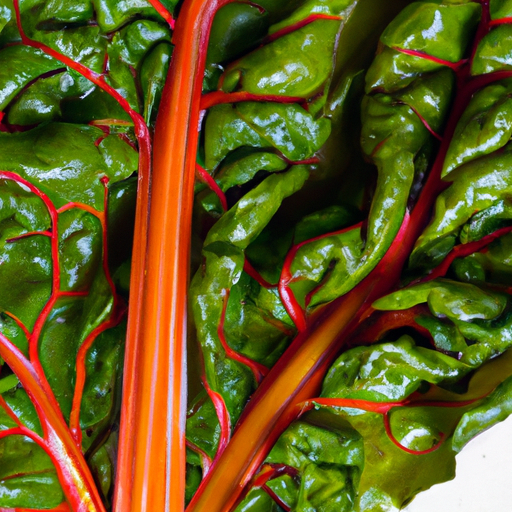Cooking with Chard: A Versatile and Nutritious Leafy Green
Chard is a leafy green vegetable that often gets overlooked in favor of its popular cousins, kale and spinach. However, this delicious and versatile ingredient deserves a spot in your kitchen. Known for its vibrant colors and distinctive taste, chard can elevate any dish with its unique flavor profile. In this blog post, we will explore the various ways you can incorporate chard into your cooking, its nutritional benefits, and some interesting facts about this underappreciated green.
Taste and Texture
Chard has a mild and slightly earthy taste with a hint of bitterness. Its leaves are tender yet firm, and the stems offer a satisfying crunch. The combination of flavors and textures makes chard a delightful addition to a variety of dishes.
Cooking with Chard
Sautéed Chard with Garlic and Lemon:
One of the simplest and most popular ways to prepare chard is to sauté it with garlic and lemon. Start by washing the chard leaves thoroughly and removing the stems. Cut the leaves into bite-sized pieces. Heat some olive oil in a pan, add minced garlic, and cook until fragrant. Add the chard leaves and sauté until they wilt. Finish with a squeeze of fresh lemon juice and a pinch of salt and pepper.
Chard in Soups and Stews:
Chard can bring a vibrant color and unique flavor to soups and stews. Whether you’re making a classic minestrone soup or a hearty vegetable stew, adding chard can take the dish to the next level. Simply chop the leaves and stems and add them to the pot during the last few minutes of cooking.
Stuffed Chard Rolls:
Chard leaves can be used as a healthy and tasty alternative to cabbage in stuffed rolls. Blanch the leaves briefly in boiling water to soften them. Fill each leaf with your preferred stuffing, such as a mixture of seasoned rice, ground meat, or vegetables. Roll them up and secure with toothpicks. Steam or bake the stuffed rolls until cooked through.
Chard Chips:
If you’re a fan of kale chips, you’ll love chard chips! Preheat your oven to 350°F (175°C). Remove the stems from chard leaves, tear them into bite-sized pieces, and toss them with olive oil, salt, and your favorite seasonings. Spread them evenly on a baking sheet and bake for about 10-15 minutes or until crispy. These delightful chips make a nutritious and low-calorie snack.
Nutritional Value
Chard is packed with essential vitamins and minerals, making it a nutritious choice for any meal. It is an excellent source of vitamins A, C, and K, along with minerals like calcium, magnesium, and potassium. Additionally, chard contains antioxidants that support overall health and well-being.
Fun Facts About Chard
- Chard is a member of the beet family, which explains its vibrant colors and similar earthy flavor profile.
- The colorful stems of chard come in a range of hues, including white, yellow, red, and even pink. These bright stems can add a pop of color to your dishes.
- Chard has been cultivated and consumed since ancient times. It is believed to have originated in the Mediterranean region and was highly regarded by the ancient Greeks and Romans.
So, the next time you’re looking to add a new leafy green to your recipes, consider giving chard a chance. Its mild flavor, vibrant colors, and impressive nutritional value make it a valuable addition to any kitchen. Experiment with different cooking methods and let chard bring a fresh twist to your favorite dishes.
Interesting Facts about Chard:
- Origin: Chard, also known as Swiss chard or silverbeet, originates from the Mediterranean region and is a member of the beet family. Its scientific name is Beta vulgaris subsp. vulgaris.
- Varieties: There are different varieties of chard, including green chard (with green leaves and white stalks), red chard (with dark red leaves and red stalks), and rainbow chard (a mix of different colored stems and dark green leaves).
- Common Uses: Chard is a versatile leafy green that is commonly used in Mediterranean and Middle Eastern cuisines. It can be sautéed, steamed, boiled, stir-fried, or added raw to salads. The leaves can be used as a substitute for spinach or kale and the stalks can be prepared similarly to asparagus.
- Nutritional Benefits: Chard is a nutrient-rich vegetable. It is an excellent source of vitamins A, C, and K, as well as magnesium, potassium, iron, and fiber. It also contains antioxidants and phytonutrients with potential health benefits.
- Unique Properties: One unique property of chard is its colorful stems, which come in various shades such as red, yellow, orange, and white. These vividly colored stems make chard an appealing vegetable for both culinary and aesthetic purposes.
- Historical Significance: Chard has a long history of cultivation and use in ancient civilizations. The ancient Greeks and Romans highly valued chard for its medicinal properties and believed it to have positive effects on digestion and liver health. It has since become a popular staple in many cuisines worldwide.




Use the share button below if you liked it.
It makes me smile, when I see it.